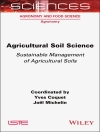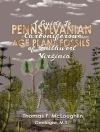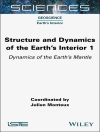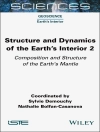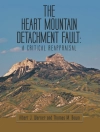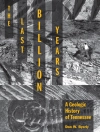Authoritative, accessible, and updated introduction to sedimentary rocks for undergraduate students
Sedimentary Petrology provides readers with a concise account of sedimentary rock composition, mineralogy, texture, structure, diagenesis, and depositional environments. The new edition of this classic text incorporates the many technological and analytical advances of the last decade, revealing exciting details of processes such as microbial precipitation, how microporosity is created within mudrocks, and the chemical composition of foraminifera deposits, which can be a key indicator for changing seawater temperature.
This fourth edition offers a comprehensive update and expansion of the previous editions with a new set of illustrations, new references, and further reading. The new co-author Stuart Jones has brought his considerable expertise in clastic sedimentology to the rewritten chapters on sandstones and mudrocks. The addition of color images throughout the text will aid students immensely in their studies and petrographic fieldwork.
Sample topics covered in Sedimentary Petrology include:
- Advances in modeling and programming to simulate depositional-diagenetic conditions and controls which support field-lab descriptions and interpretations
- Ocean acidification and the demise of coral reefs, and the role of the oceans in carbon capture and storage
- Sedimentary ironstones and iron-formations, sedimentary phosphate deposits, coal, oil shale and petroleum, and cherts and siliceous sediments
- Limestones, evaporites, volcaniclastic sediments, sandstones, conglomerates, breccias, and the effects of microplastics on marine organisms
Aimed at undergraduates in geology and earth science, Sedimentary Petrology is an excellent teaching and learning resource for introductory courses in sedimentary rocks.
Innehållsförteckning
Preface to Fourth Edition xiv
Preface to the Third Edition xv
Biographies xvi
1 Introduction: Basic Concepts and Approach 1
1.1 Introduction
1
1.2 Basic
Concepts 1
1.2.1 Classification of Sedimentary Rocks 1
1.2.2 Sedimentary Environments and Facies 2
1.2.2.1 Facies 2
1.2.2.2 Facies Models 2
1.2.3 Controls on Deposition: Tectonics, Climate and Sea Level 3
1.2.3.1 Climate 4
1.2.3.2 Sea Level 4
1.2.4 Stratigraphic Practice 5
1.2.5 Sequence Stratigraphy 7
1.2.5.1 Introduction 7
1.2.5.2 Accommodation and Sedimentation Rates 7
1.2.5.3 Scale and Order 8
1.2.5.4 Stratigraphic Sequences, Key Surfaces, Systems Tracts 8
1.2.5.5 Metre-Scale
Cycles, High-Frequency
Sequences, Parasequences 11
1.2.6 Diagenesis 13
1.3 Methodology
13
1.3.1 In the Field 13
1.3.2 In the Laboratory 15
1.3.3 The Sedimentological Literature 17
Further
Reading 18
2 Siliciclastic Sediments I: Sandstones, Conglomerates and Breccias 19
2.1 Introduction
19
2.2 Sediment
Texture 19
2.2.1 Grain Size and Grain-size
Parameters 21
2.2.1.1 Interpretation and Use of Grain-size
Analyses 26
2.2.2 Grain Morphology 27
2.2.3 Grain-surface
Texture 28
2.2.4 Grain Fabric 29
2.2.5 Textural Maturity 30
2.3 Sedimentary
Structures 31
2.3.1 Erosional Sedimentary Structures 31
2.3.2 Depositional Sedimentary Structures 34
2.3.2.1 Sediment Transport and Aqueous Flows 34
Contents
0005399227.INDD 7 12-29-2022 11:54:51
viii Contents
2.3.2.2 Bedding and Lamination 39
2.3.2.3 Current Ripples, Dunes and Cross-Stratification 40
2.3.2.4 Flaser and Lenticular Bedding 44
2.3.2.5 Antidunes and Antidune Bedding 45
2.3.2.6 Wave-formed
Ripples and Cross-Lamination
45
2.3.2.7 Hummocky Cross-Stratification (HCS) 46
2.3.2.8 Wind Ripples, Dunes, Draas and Aeolian Cross-bedding
47
2.3.2.9 Graded Bedding 50
2.3.2.10 Mudcracks: Desiccation and Syneresis 51
2.3.3 Post-depositional
Sedimentary Structures 52
2.3.4 Biogenic Sedimentary Structures 56
2.4 Palaeocurrent
Analysis 60
2.4.1 Palaeocurrent Indicators 61
2.5 Detrital
Components of Siliciclastic Sediments 63
2.5.1 Rock Fragments 64
2.5.2 Quartz 65
2.5.3 Feldspars 67
2.5.4 Micas 69
2.5.5 Clay Minerals 69
2.5.6 Heavy Minerals 70
2.5.7 Other Detrital Components 71
2.5.8 Compositional Maturity 71
2.6 Classification
of Siliciclastic Sediments 72
2.6.1 Classification of Sandstones 72
2.6.2 Conglomerates and Breccias 75
2.6.2.1 Composition and Textures of Conglomerates 75
2.7 Petrography
and Origin of Principal Sandstone Types 77
2.7.1 Quartz Arenites 77
2.7.2 Arkoses 79
2.7.3 Litharenites 79
2.7.4 Greywackes 79
2.8 Sandstone
Composition, Provenance and Tectonic Setting 82
2.9 Sandstone
Diagenesis 84
2.9.1 Compaction and Pressure Dissolution 86
2.9.2 Silica Cementation 88
2.9.3 Carbonate Cementation 91
2.9.4 Feldspar Authigenesis 93
2.9.5 Clay-mineral
Authigenesis 93
2.9.6 Hematite Cementation and Pigmentation: Red Beds 97
2.9.7 Diagenetic Environments and Sequences 98
2.9.8 Diagenesis and Sequence Stratigraphy 102
2.9.9 CO2 Sequestration into Sandstone Reservoirs 104
2.10 Porosity
and Permeability 104
2.11 Sediment
Routing Systems 108
2.12 Depositional
Environments of Sandstones and Coarser Clastics 110
2.12.1 Fluvial Systems and Facies 110
2.12.1.1 Alluvial Fan Facies 111
2.12.1.2 Meandering-stream
Facies 117
2.12.1.3 Anastomosing-stream
Facies 119
2.12.2 Desert Environments and Aeolian Sand Facies 121
2.12.3 Lacustrine Environments and Sandy Facies 122
2.12.4 Deltaic Environments and Facies 124
0005399227.INDD 8 12-29-2022 11:54:51
Contents ix
2.12.4.1 River-dominated
Deltas 127
2.12.4.2 Wave-dominated
Deltas 128
2.12.4.3 Tide-dominated
Deltas 129
2.12.4.4 Ancient Deltas 130
2.12.4.5 Fan Deltas 130
2.12.5 Marine Shoreline Environments and Facies 131
2.12.5.1 Beach-barrier
Island and Strandplain Systems 131
2.12.5.2 Tidal Flats 135
2.12.5.3 Estuaries and Incised Valleys 135
2.12.6 Shallow-marine
Shelves, Epeiric Seas and Their Facies 136
2.12.6.1 Tidal Bedforms and Sand Sheets 136
2.12.6.2 Tidal Sand Banks 138
2.12.6.3 Non-tidal
Offshore Sand Bodies 138
2.12.7 Continental Margins and Deep-water
Basins 139
2.12.8 Glacial Environments 146
2.13 Facies
Sequences, Controls and Sequence Stratigraphy 148
2.13.1 Facies Sequences and Controls 148
2.13.2 Sequence Stratigraphy 149
References 151
Further Reading 164
3 Siliciclastic Sediments II: Mudrocks 166
3.1 Introduction
166
3.2 Textures
and Structures of Mudrocks 166
3.2.1 Nodules and Concretions 169
3.3 The
Colour of Mudrocks 173
3.4 Mineral
Constituents of Mudrocks 173
3.4.1 Clay Minerals 174
3.4.2 Quartz 177
3.4.3 Organic Matter 177
3.4.4 Other Constituents 177
3.5 The
Formation and Distribution of Clay Minerals in Modern Sediments 179
3.6 Diagenesis
of Clay Minerals and Mudrocks 181
3.6.1 Early (Shallow) Diagenesis 181
3.6.2 Burial (Deeper) Diagenesis 184
3.7 Mudrocks
and Their Depositional Environments 186
3.7.1 Residual Mudrocks and Soils 187
3.7.2 Detrital Mudrocks 189
3.7.2.1 Non-marine
Mudrocks 189
3.7.2.2 Marine Mudrocks 190
3.7.2.3 Organic-rich
Mudrocks and Black Shales 192
3.7.2.4 Shale Gas 193
3.7.2.5 Mud Diapirism and Mud Volcanoes 194
3.7.2.6 Loess and Loessite 195
3.7.3 Mudrocks of Volcaniclastic Origin 197
3.7.4 Temporal (and Spatial) Variations in Mudrock Sequences 197
References 198
Further Reading 203
4 Carbonate Sediments: Limestones and Dolomites 204
4.1 Introduction
204
4.2 Techniques
for the Study of Carbonate Sediments 205
0005399227.INDD 9 12-29-2022 11:54:52
x Contents
4.2.1 In the Field 205
4.2.2 The Petrographic Study of Carbonates 205
4.2.3 Isotopes and Trace Elements 207
4.3 Mineralogy
of Carbonate Sediments 209
4.4 Carbonate
Production and Factories 210
4.4.1 Carbonate Factories 211
4.4.2 Controls on Carbonate Production and Deposition 212
4.5 Components
of Carbonate Rocks 214
4.5.1 Non-skeletal
Grains 214
4.5.1.1 Ooids and Pisoids 214
4.5.1.2 Ancient Marine Ooids 217
4.5.1.3 Origin of Ooids and Seawater Chemistry Through Time 217
4.5.1.4 Peloids 219
4.5.1.5 Aggregates and Intraclasts 220
4.5.2 Skeletal Components (excluding Algae and Microbes) 220
4.5.2.1 Mollusca 221
4.5.2.2 Brachiopods 224
4.5.2.3 Cnidaria (especially Corals) 225
4.5.2.4 Echinodermata 226
4.5.2.5 Bryozoa 226
4.5.2.6 Foraminifera 227
4.5.2.7 Other Carbonate-forming
Organisms 228
4.5.3 The Contribution of Microbes to Carbonates 230
4.5.3.1 Rhodophyta (Red Algae) 230
4.5.3.2 Chlorophyta (Green Algae) 231
4.5.3.3 Chrysophyta (Yellow-green
Algae, Coccoliths) 232
4.5.3.4 Calcified Cyanobacteria and Algae (Calcimicrobes) 232
4.5.3.5 Micrite Envelopes and Microbial Micritisation 233
4.5.3.6 Microbialites: Stromatolites, Thrombolites and Oncoids 233
4.5.4 Lime Mud and Micrite 238
4.6 Classification
of Limestones 239
4.6.1 Classification Schemes 239
4.6.2 Carbonate Microfacies and Standard Microfacies Types (SMF) 241
4.7 Limestone
Grain Size and Texture 243
4.8 Sedimentary
Structures of Limestones 244
4.8.1 Bedding Planes, Hardgrounds, Tepees and Palaeokarstic Surfaces 244
4.8.2 Current and Wave Structures 247
4.8.3 Cavity Structures 248
4.9 Carbonate
Diagenesis 251
4.9.1 Marine Diagenesis 252
4.9.1.1 Marine Diagenesis in Recent Carbonate Sediments 252
4.9.1.2 Marine Diagenesis in Ancient Limestones 256
4.9.1.3 Discussion of Marine Cements 259
4.9.2 Meteoric Diagenesis 260
4.9.2.1 Ancient Meteoric Calcite Cements 262
4.9.3 Calcite Spar: A Meteoric and Burial Cement 263
4.9.3.1 Origin of Calcite Spar 264
4.9.4 Neomorphism (Recrystallisation) 264
4.9.4.1 Microspar–pseudospar; Aggrading Neomorphism 265
4.9.4.2 Calcitisation of Aragonite Grains and Cements 266
4.9.4.3 Degrading Neomorphism 266
4.9.5 Modelling Limestone Diagenesis 266
0005399227.INDD 10 12-29-2022 11:54:52
Contents xi
4.9.6 Compaction 266
4.9.6.1 Differential Compaction 268
4.10 Dolomitisation
and Dedolomitisation 269
4.10.1 Dolomites: Nature and Occurrence 269
4.10.2 Origin of Dolomites and Dolomitisation Models 274
4.10.2.1 Modern Dolomites 274
4.10.2.2 Ancient Dolomites 275
4.10.2.3 Seawater Dolomitisation 276
4.10.2.4 Burial Dolomitisation and Hydrothermal Dolomite (HTD) 277
4.10.3 Modelling Dolomitisation 278
4.10.4 Dedolomitisation (Calcitisation of Dolomite) 279
4.11 Silicification
of Limestones 281
4.12 Porosity
in Carbonate Sediments 281
4.12.1 Carbonate Paragenesis and Burial History Plots 283
4.13 Carbonate
Depositional Environments and Facies 283
4.13.1 Non-marine
Carbonate Sediments 283
4.13.1.1 Lacustrine Limestones 284
4.13.1.2 Pedogenic Carbonates: Calcrete and Dolocrete 286
4.13.1.3 Spring Carbonates: Tufa and Travertine 289
4.13.2 Marine Carbonates and Carbonate Platforms 291
4.13.3 Shelf and Ramp Systems: Facies Belts and Standard Microfacies 293
4.13.4 Intertidal–supratidal Carbonates 293
4.13.5 Lagoonal Limestones 294
4.13.6 Intertidal–subtidal Carbonate Sand Bodies and Storm Deposits 295
4.13.7 Offshore Shelf-ramp
Carbonates: Storm Deposits, Internalites, Limestone-Mud/
Marl Alternations
(Ribbon Rocks) 297
4.13.7.1 Storm Beds and Banks 297
4.13.8 Reefs and Carbonate Buildups 298
4.13.8.1 Reefs as Hydrocarbon Reservoirs 301
4.13.9 Pelagic Limestones 301
4.13.10 Resedimented Deeper-water
Limestones 303
4.14 Carbonate
Sequence Stratigraphy and Forward Modelling 306
4.14.1 Sequence Stratigraphy of Carbonate Shelves 306
4.14.2 Sequence Stratigraphy of Carbonate Ramps 308
4.14.3 Sequence Stratigraphy of Mixed Siliciclastic–Carbonate Successions 309
4.14.4 Metre-scale
Cycles (Parasequences) and their Stacking Patterns 309
4.14.5 Diagenesis and Sequence Stratigraphy 311
4.14.6 Modelling Carbonate Stratigraphy, Sequences and Cycles 311
References 312
Further Reading 325
Websites 325
5 Evaporites 326
5.1 Introduction
326
5.1.1 Techniques for Studying Evaporites 326
5.1.2 Early Geochemical Work 326
5.2 Evaporite
Deposits and Depositional Environments 328
5.3 Gypsum
and Anhydrite 331
5.3.1 Sabkha Sulphate and Nodular Anhydrite 332
5.3.2 Bottom-growth
Gypsum 332
5.3.3 Laminated Gypsum/Anhydrite 333
5.3.4 Resedimented Gypsum-Anhydrite
336
0005399227.INDD 11 12-29-2022 11:54:52
xii Contents
5.3.5 Secondary and Fibrous Gypsum 336
5.3.6 Burial Anhydrite 337
5.4 Halite
337
5.5 Other
Evaporite Minerals and Their Occurrence 341
5.5.1 Potassium and Magnesium Salts 341
5.5.2 Lacustrine Evaporites 342
5.6 Evaporite
Dissolution and Replacement 343
5.7 Evaporite
Sequences and Discussion 345
5.8 Evaporites
Through Time 349
5.9 Evaporites,
Diapirism, Deformation and Decollement 350
References 350
Further Reading 353
6 Sedimentary Ironstones and Iron Formations 354
6.1 Introduction
354
6.1.1 Techniques for the Study of Ironstones and Iron Formations 354
6.2 Source
and Transportation of Iron 355
6.3 Formation
of the Principal Iron Minerals 356
6.4 Occurrence
and Petrography of Iron Minerals 359
6.4.1 Iron Oxides 359
6.4.2 Iron Carbonates 360
6.4.3 Iron Sulphides 361
6.4.4 Iron Silicates 361
6.5 Precambrian
Iron Formations and Phanerozoic Ironstones 364
6.5.1 Precambrian Iron Formations 365
6.5.2 Phanerozoic Ironstones 368
6.6 Bog
Iron Ores 370
6.7 Ferromanganese
Nodules and Crusts, and Metalliferous Sediments 370
References 372
Further Reading 374
7 Sedimentary Phosphate Deposits 375
7.1 Introduction
375
7.1.1 Techniques for Studying Phosphorites 375
7.2 Mineralogy
375
7.3 Nodular
and Bedded Phosphorites 376
7.3.1 Recent–Subrecent Occurrences 376
7.3.2 Origin of Marine Phosphorites 376
7.3.3 Ancient Phosphorite Sequences 379
7.4 Bioclastic
and Pebble-Bed
Phosphorites 381
7.5 Guano
and Ocean-Island
Phosphorites 382
References 382
Further Reading 383
8 Coal and Petroleum 384
8.1 Introduction
384
8.2 Modern
Organic Deposits 384
8.3 Ancient
Organic Deposits 385
8.4 Coals
and the Coal Series 386
8.4.1 Humic Coals 388
8.4.2 Sapropelic Coals 388
8.5 Coal
Petrology 388
8.5.1 Organic Constituents 388
8.5.2 Inorganic Constituents 390
8.5.3 Gas in Coal 391
8.5.4 Coal Balls 391
8.6 Coal
Formation and Rank 391
8.6.1 Chemical Considerations 391
8.6.2 Rank, Depth and Temperature 392
8.7 Occurrence
of Coal 392
8.8 Formation
of Kerogen 394
8.9 Petroleum
395
8.9.1 Composition and Occurrence 395
8.9.2 Formation of Petroleum 397
References
399
Further
Reading 400
9 Cherts and Siliceous Sediments 401
9.1 Introduction
401
9.1.1 Techniques for Studying Chert 401
9.2 Chert
Petrology 402
9.3 Bedded
Chert 404
9.3.1 Siliceous Ooze and Bedded Chert 404
9.3.1.1 Modern and Phanerozoic 404
9.3.1.2 Precambrian Cherts 406
9.3.2 The Origin of Chert 407
9.4 Nodular
Chert 410
9.5 Non-
Marine
Siliceous Sediment and Chert 413
References 415
Further Reading 417
Index 418
Om författaren
Maurice E. Tucker graduated from Durham University and obtained his Ph D from the University of Reading. He spent nearly 30 years at Durham University and is now a Visiting Professor at the University of Bristol.
Stuart J. Jones graduated in Geology from Aberystwyth University and received his Ph D from the University of Reading. He is currently an Associate Professor of Sedimentology at Durham University.



